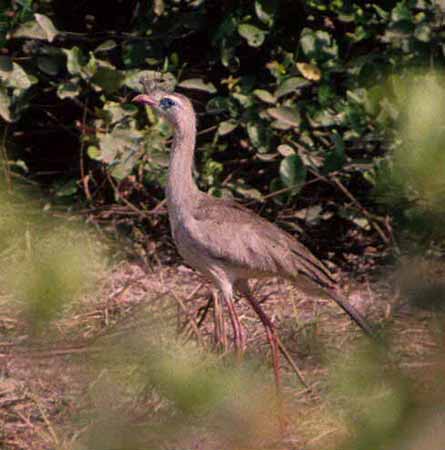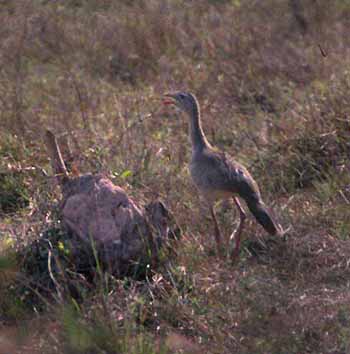SERIEMAS Cariamidae
-
Species in family 2
-
Species observed [DR] 1 (50%)
-
Species photo'd [DR] 1
 When the BBC program "Life of Birds" with David Attenborough chose a modern
bird to illustrate how prehistoric Archaeopteryx might have evolved
the power of flight over epochs of time, from a fast-running predatory
dinosaur to a short-gliding long-legged bird, they chose to morph
the fossil beast into today's Red-legged Seriema (left). And indeed,
today's two species of seriema in southern South America appear to be derived
from Pleistocene fossil birds which were once giant, flightless predators
(known as phorusrhacoids) of now-extinct fauna (Gonzaga 1996). The Seriemas
are an ancient and poorly-known group of but two species -- the Red-legged
and the Black-legged Chunga burmeisteri -- and both are diurnal
hunters in semi-open drier landscapes south of the Amazon basin. The Red-legged
is more widespread, ranging in cerrado vegetation from eastern Brazil to
central Argentina, while the Black-legged in a bird of Chaco woodlands
in Paraguay and northern Argentina.
When the BBC program "Life of Birds" with David Attenborough chose a modern
bird to illustrate how prehistoric Archaeopteryx might have evolved
the power of flight over epochs of time, from a fast-running predatory
dinosaur to a short-gliding long-legged bird, they chose to morph
the fossil beast into today's Red-legged Seriema (left). And indeed,
today's two species of seriema in southern South America appear to be derived
from Pleistocene fossil birds which were once giant, flightless predators
(known as phorusrhacoids) of now-extinct fauna (Gonzaga 1996). The Seriemas
are an ancient and poorly-known group of but two species -- the Red-legged
and the Black-legged Chunga burmeisteri -- and both are diurnal
hunters in semi-open drier landscapes south of the Amazon basin. The Red-legged
is more widespread, ranging in cerrado vegetation from eastern Brazil to
central Argentina, while the Black-legged in a bird of Chaco woodlands
in Paraguay and northern Argentina.
 There
has been and continues to be much debate about the taxonomic relationship
of seriemas. In older times they were grouped with that other diurnal bird
of prey that runs on long legs, the Secretarybird Sagittarius serpentarius
of
Africa, but more recent evidence (including tentative DNA results) has
placed the seriemas in the Gruiformes (cranes/rails order) rather than
the Falconiformes to which the Secretarybird belongs. But whether seriemas
are most closely related to trumpeters (Psophiidae), bustards (Otididae),
or the New Caledonia single-species family, the Kagu Rhynochetos jubatus,
remains unknown (Gonzaga 1996).
There
has been and continues to be much debate about the taxonomic relationship
of seriemas. In older times they were grouped with that other diurnal bird
of prey that runs on long legs, the Secretarybird Sagittarius serpentarius
of
Africa, but more recent evidence (including tentative DNA results) has
placed the seriemas in the Gruiformes (cranes/rails order) rather than
the Falconiformes to which the Secretarybird belongs. But whether seriemas
are most closely related to trumpeters (Psophiidae), bustards (Otididae),
or the New Caledonia single-species family, the Kagu Rhynochetos jubatus,
remains unknown (Gonzaga 1996).
I found the Red-legged Seriema to be difficult to see in southwestern
Brazil. Although pairs are highly vocal -- their loud yelping cries (like
young dogs) are characteristic of the cerrado -- they are amazingly elusive
in thick cerrado vegetation, and our short glimpses were usually when one
or two dashed across a small opening. Seriemas are generally considered
wary, and they tend to run from danger. They are surprisingly large birds
-- as big as the Secretarybird in my recollection, which could be wrong
-- and even reading about them ahead of time had not prepared me for their
size. When foraging, birds stalk deliberately, scrutinizing the ground.
Their diet is a catholic run of animal prey, from grasshoppers and beetles
to snakes, lizards, and rodents (Gonzaga 1996).
"Seriema" is from the local Indian word "cariama" which means "the one
who wears a short crest." This crest can just barely be seen in the upper
photo. Cariama is now latinized as its generic name.
Photos: The photos of Red-legged Seriema
Cariama
cristata were taken in the Pantanal south of Pocone, Mato Grosso, Brazil,
in July 1999. Photos © D. Roberson; all rights reserved.
Bibliographic note:
There is no "family book" per se of which I'm aware, but an excellent
introduction to the family is in Gonzaga (1996).
Literature cited:
Gonzaga, L. P. 1996. Family Cariamidae (Seriemas) in del Hoyo,
J., Elliott, A., & Sargatal, J., eds. Handbook of the Birds of the
World. Vol. 3. Lynx Edicions, Barcelona.
TOP
BACK TO HOME
PAGE
BACK TO LIST OF
BIRD FAMILIES OF THE WORLD
 There
has been and continues to be much debate about the taxonomic relationship
of seriemas. In older times they were grouped with that other diurnal bird
of prey that runs on long legs, the Secretarybird Sagittarius serpentarius
of
Africa, but more recent evidence (including tentative DNA results) has
placed the seriemas in the Gruiformes (cranes/rails order) rather than
the Falconiformes to which the Secretarybird belongs. But whether seriemas
are most closely related to trumpeters (Psophiidae), bustards (Otididae),
or the New Caledonia single-species family, the Kagu Rhynochetos jubatus,
remains unknown (Gonzaga 1996).
There
has been and continues to be much debate about the taxonomic relationship
of seriemas. In older times they were grouped with that other diurnal bird
of prey that runs on long legs, the Secretarybird Sagittarius serpentarius
of
Africa, but more recent evidence (including tentative DNA results) has
placed the seriemas in the Gruiformes (cranes/rails order) rather than
the Falconiformes to which the Secretarybird belongs. But whether seriemas
are most closely related to trumpeters (Psophiidae), bustards (Otididae),
or the New Caledonia single-species family, the Kagu Rhynochetos jubatus,
remains unknown (Gonzaga 1996).
 When the BBC program "Life of Birds" with David Attenborough chose a modern
bird to illustrate how prehistoric Archaeopteryx might have evolved
the power of flight over epochs of time, from a fast-running predatory
dinosaur to a short-gliding long-legged bird, they chose to morph
the fossil beast into today's Red-legged Seriema (left). And indeed,
today's two species of seriema in southern South America appear to be derived
from Pleistocene fossil birds which were once giant, flightless predators
(known as phorusrhacoids) of now-extinct fauna (Gonzaga 1996). The Seriemas
are an ancient and poorly-known group of but two species -- the Red-legged
and the Black-legged Chunga burmeisteri -- and both are diurnal
hunters in semi-open drier landscapes south of the Amazon basin. The Red-legged
is more widespread, ranging in cerrado vegetation from eastern Brazil to
central Argentina, while the Black-legged in a bird of Chaco woodlands
in Paraguay and northern Argentina.
When the BBC program "Life of Birds" with David Attenborough chose a modern
bird to illustrate how prehistoric Archaeopteryx might have evolved
the power of flight over epochs of time, from a fast-running predatory
dinosaur to a short-gliding long-legged bird, they chose to morph
the fossil beast into today's Red-legged Seriema (left). And indeed,
today's two species of seriema in southern South America appear to be derived
from Pleistocene fossil birds which were once giant, flightless predators
(known as phorusrhacoids) of now-extinct fauna (Gonzaga 1996). The Seriemas
are an ancient and poorly-known group of but two species -- the Red-legged
and the Black-legged Chunga burmeisteri -- and both are diurnal
hunters in semi-open drier landscapes south of the Amazon basin. The Red-legged
is more widespread, ranging in cerrado vegetation from eastern Brazil to
central Argentina, while the Black-legged in a bird of Chaco woodlands
in Paraguay and northern Argentina.